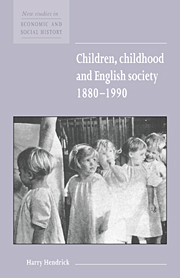Book contents
- Frontmatter
- Contents
- Acknowledgements
- 1 Introduction
- 2 New ideas of childhood: the 1880s to the 1920s
- 3 Parent–child relationships
- 4 Children and social policies
- 5 Children, schooling and the classroom
- 6 Children's leisure
- 7 Conclusion: disappearing childhood and children's rights
- Bibliography
- Index
- Titles available in the New Studies in Economic and Social History series
- Titles available in the Studies in Economic and Social History series
- Economic History Society
2 - New ideas of childhood: the 1880s to the 1920s
Published online by Cambridge University Press: 05 June 2012
- Frontmatter
- Contents
- Acknowledgements
- 1 Introduction
- 2 New ideas of childhood: the 1880s to the 1920s
- 3 Parent–child relationships
- 4 Children and social policies
- 5 Children, schooling and the classroom
- 6 Children's leisure
- 7 Conclusion: disappearing childhood and children's rights
- Bibliography
- Index
- Titles available in the New Studies in Economic and Social History series
- Titles available in the Studies in Economic and Social History series
- Economic History Society
Summary
There is a broad consensus among historians that during the late Victorian and Edwardian years new ideas or, in the language of social science, ‘social constructions’ of children and childhood gained currency and became widely acceptable social truths. The emphasis is on the word ‘new’, for this was not the first time that such ideas, perceptions, concepts – call them what you will – had undergone change. Classical scholars and medieval and early modern historians have also discussed the meanings and understandings of childhood for their respective periods [42–6]. And it is equally true that definitions of childhood, along with the relationships between children and society, changed repeatedly from the early 1700s through to the mid-nineteenth century under the following influences: the Enlightenment, the Rousseauian theory of Nature, the Industrial Revolution, the Romantics and the Evangelical revival [47, 48]. Consequently, the late nineteenth and early twentieth century developments were further stages in what was a continually shifting process.
But let us be clear as to the meaning of ‘social construction’. This is an important term because much of what has been written about the history of children and childhood is the work of historians whose methodological framework, such as it is, has been influenced by social scientific writings, and of practising scholars in the social sciences. Put simply, the term refers to the way in which our lives and our institutions are socially produced, i.e. by ourselves, rather than naturally or divinely given.
- Type
- Chapter
- Information
- Children, Childhood and English Society, 1880–1990 , pp. 9 - 15Publisher: Cambridge University PressPrint publication year: 1997



